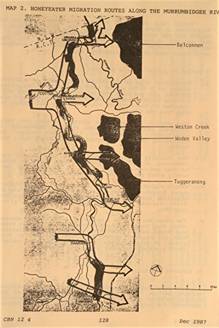My map only related to an issue raised about the direction
of the 'main' migration. The BA atlas only gives presence information,
expressed in relative frequency of observations. I began by making the
winter and summer maps semi-transparent and superimposing them, thus comparing relative
'presence' observations. The result was interesting, but rather
complicated so I showed the essence of it in that different form. One
point that emerges is that the winter and summer distributional maps, having
regard only to crude presence, are not all that different except around the
margins.
Clearly birds leave some areas and birds concentrate in
others, but it would be a rash assumption that the 'leaving' birds make up the
'arriving' ones, geographically speaking.
Micro-surveys, like the one in CBN 12:4 (1987), are
useful for local purposes but are of little - let’s be frank, no - use in
understanding the overall flow.

I suspect that the constant emphasis on temperature is
misplaced, as if the birds were sun-mad Victorians making for the beaches of
Noosa, and that the migration is food (ie vegetation cycle) driven, and that
accounts for the differences noticed each year. Transient parties will
linger or concentrate around the ACT if there is food, but not otherwise.
-----Original Message-----
From: Elizabeth Compston [
Sent: Wednesday, 12 March 2008 9:55 AM
To: birds birds
Subject: migrating honey eaters
I am interested in the map that Geoffrey has recently
provided of the
migration routes of the yellow faced honey eaters in
Autumn. I have
felt for some time that the birds we have been seeing
flocking down
the Murrumbidgee in Autumn, have come from further afield
than the
Brindabella Mountains. In 2003, the year of the
fires in the
Brindabellas thousands of yfhes flew along the
Murrumbidgee corridor,
also in 2004. I am not sure about 2005, but in 2006
and 2007, there
were far fewer birds; which to me could indicate that
many birds had
perished in the fires in Victoria. However, it
could also just
indicate that they were flying along different
routes. I would like
comments from Nickie Taws and others about this
As to whether the yfhes appeared in Canberra earlier than
usual, I
doubt this. In 2002, 2003, and 2004 I asked people
to report
sighting of yfhes in Canberra. I have kept these
records. On March
6th, 2003, Bob Rusk wrote "Over the past couple of
weeks, it is
obvious that the yfhe migration has begun". There
are so many
variables involved in the start of the migration. And are
sightings
of the birds, flying through Canberra in small numbers,
an indication
of start of migration anyway?
Now that the early autumn has given way to summer again,
what effect
will this have on the birds? Not so many sightings
since the weather
warmed up? What day was that? Keep observations
coming in
Elizabeth
*******************************************************************************************************
This is the email announcement and discussion list of the
Canberra Ornithologists Group.
List-Post:
<>
List-Help:
<>
List-Unsubscribe:
<>
List-Subscribe:
<>
List archive:
<http://bioacoustics.cse.unsw.edu.au/archives/html/canberrabirds>
List manager: David McDonald, email
<>

